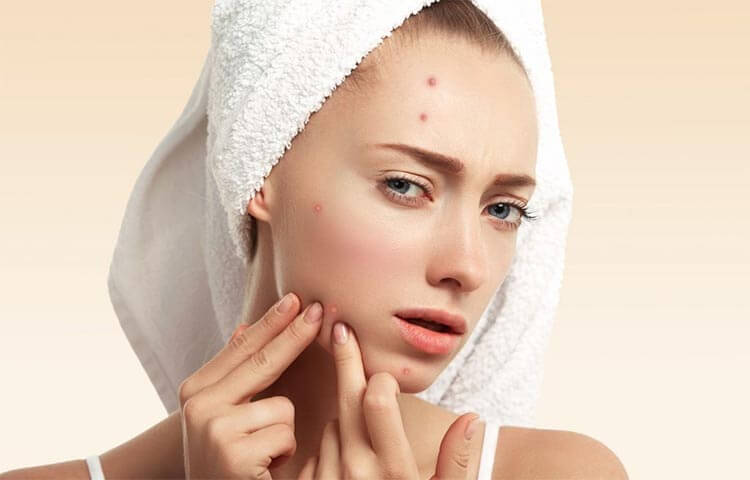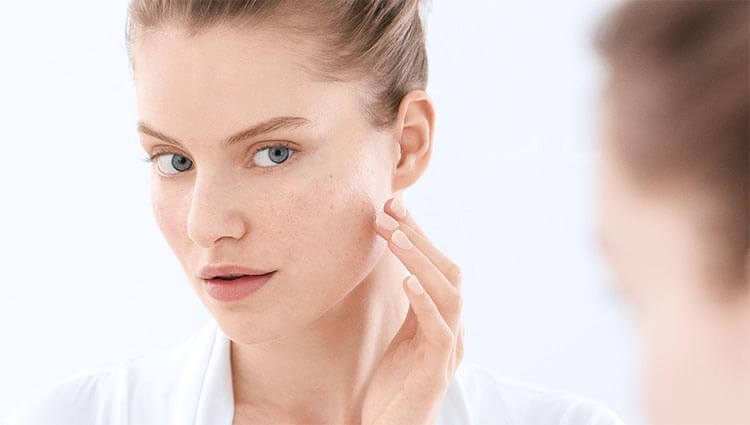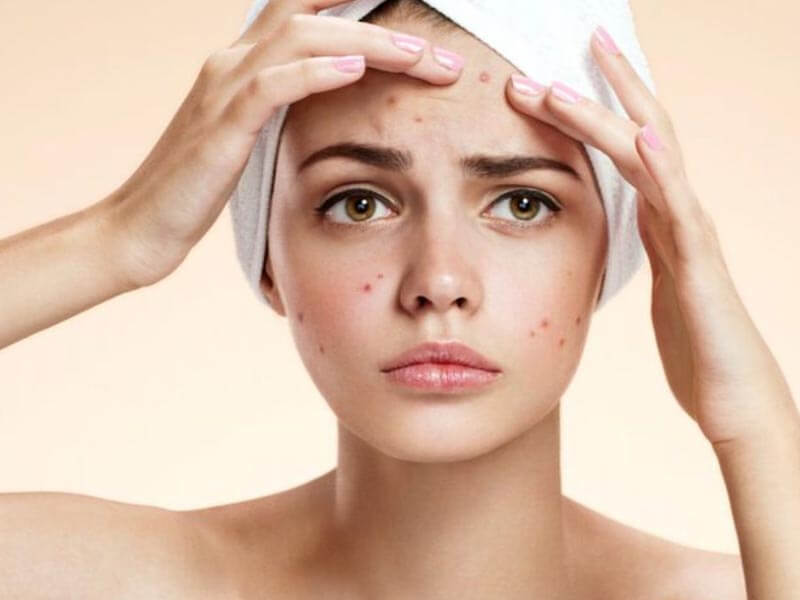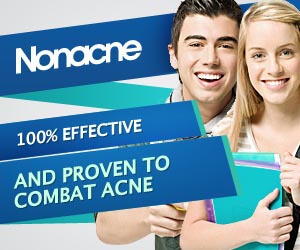Hormonal acne is one of the forms of acne vulgaris, which affects the vast majority of adult women. Its occurrence is associated with the functioning of the endocrine system and periodic changes in hormone concentrations. This variety is more difficult to cure and unfortunately requires the help of a specialist dermatologist and endocrinologist. Nevertheless, it is worth mentioning that in the fight against hormonal acne, it is also worthwhile to use home-made and naturally-based methods.
Table of content
- Causes of hormonal acne
- How does hormonal acne manifest itself?
- What tests should be carried out?
- Hormonal acne treatment methods
- Oral therapy
- Proper care – natural treatment
- Diet for hormonal acne
Causes of hormonal acne
The occurrence of hormonal acne is associated with an increase or decrease in the concentration of certain hormones, which leads to increased activity of the sebaceous glands and overproduction of sebum. This inevitably leads to clogging of the lines carrying the secretion outside and the appearance of painful pustules, lumps and nodules on the skin of the face, neck, back and cleavage. Studies show that an increase in the concentration of estrogen, female sex hormones, affects the appearance of various unsightly skin lesions. These hormonal disorders most often concern androgens; testosterone, dihydrotestosterone and androstenediol; which stimulate sebum secretion and overproduction. This is how an ideal environment is created for the multiplication of anaerobic bacteria and inflammation.


How does hormonal acne manifest itself?
Hormonal acne can manifest itself in many ways, as it depends on which hormones contributed to the disorder. Nevertheless, it is most often characterized by skin lesions on the face, neck and back in the form of large and painful lumps and blackheads. The complexion is also greasy and shiny, which is a result of overproduction of sebum. When oestrogen is responsible for the appearance of acne, efflorescences appear on the forehead, cheeks, nose and chin. They manifest themselves as baking or itchy pustules and lumps.
Among the most frequent skin lesions in hormonal acne there are numerous unaesthetic blackheads (open and closed), lumps, pustules, nodules and purulent cysts occurring on the skin of the face; mainly forehead, chin and jaw line;, neck, cleavage and back. Skin changes are often accompanied by a painful and strongly inflamed condition.
The most common symptoms:
- Lumps, pustules and blackheads on the chin, around the mouth, along the jaw line, around the neck and on the back,
- reddening, which over time turns into itchy and baking lumps or red pimples,
- Inflammatory infiltrations on the skin.
What tests should be carried out?
If hormonal acne is suspected, the dermatologist will order tests to confirm this hypothesis and to determine the treatment. Hormone tests help determine the concentration of hormones, such as:
- Thyroid hormones,
- Prolactin,
- Insulin,
- Testosterone free,
- Total testosterone,
- Dehydroepiandrosterone (DHEA),
- Luteinizing hormone (LH),
- Foliculotropic hormone (FSH).
Hormonal acne treatment methods
When starting to treat hormonal acne, the most effective therapy should be individually adjusted to the patient. We must be aware that treatment can last for as long as a few months, and that it involves the use of oral preparations and local pharmacological agents in the form of creams and ointments. Treatment with antibiotics brings the best results combined with proper skin care. This care should include the use of cosmetics for acne-prone skin, deprived of ethanol. After proper facial skin cleansing, it is advisable to use moisturising creams which contributes to the removal of sebum and exfoliated epidermis, improving skin condition and preventing new changes.


Oral therapy
It involves the patient taking antibiotics or retinoids and the treatment itself usually lasts at least several months. It is not advisable to expose sick parts of the body to the sun, and at the same time it is necessary to apply preparations providing sun protection to the skin. If you decide to use vitamin A derivatives, you must not become pregnant for several months after the end of the treatment. As far as men are concerned, they shoul not try to have offspring, because the medicine can damage half of them. Contraception is then necessary. Due to the increased dryness of the skin and mucous membranes, ointments and creams with antibiotics, among others, are used on the skin. You can also use a wide range of acne tablets available without a prescription. They are fully safe and provide high effectiveness in removing blackheads.
Proper care – natural treatment
When dealing with the problem of hormonal acne, we should put particular emphasis on proper skin care. The use of appropriate preparations for its cleansing will help to remove impurities, dead epidermis and bacteria, and what is important, it will not lead to the multiplication of bacteria. When cleansing your face, choose micellar liquids, gels and tonics for sensitive skin without alcohol. Do not forget to moisturise the skin properly so as not to lead to excessive production of sebum. Remember to avoid creams containing mineral oils and perfumed ingredients with a wide arc. Choose products with exfoliating, antibacterial and anti-seborrheic properties. Single changes are effective with spot preparations which contain tea tree oil and zinc in their composition.
The natural methods of fighting acne include the herbs of the violet tricolour (common pansies), nettle leaf, field horsetail herb or small-flowered willow herb. Variety of the diet with the mentioned herbs has a positive effect on the whole organism as they improve metabolism, cleanse the organism of unnecessary products of metabolism and reduce seborrhea.
Diet for hormonal acne
The treatment process can also be supported by an appropriately composed diet rich in vitamins and nutrients which support the regenerative processes of the epidermis. It is recommended to consume products containing vitamins A, E, C and B as well as zinc and selenium. We should avoid processed dishes, fast foods, spices and products with a high glycemic index.



